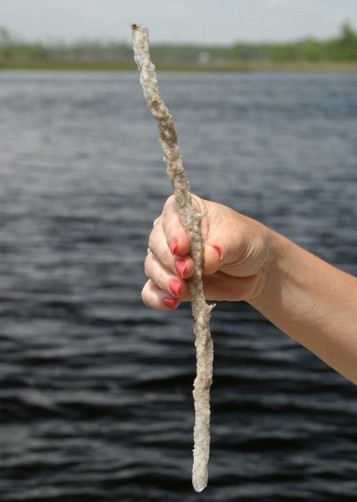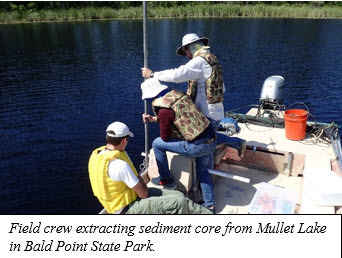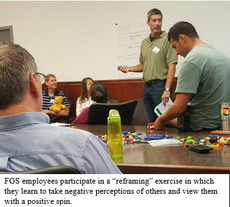|
Greetings, and welcome to
the 2016 fall edition of FGS News and Research. This issue features innovative research
related to karst geology and geochemistry. At request of the Suwannee River Water Management District (SRWMD), FGS
staff successfully conducted the Dead River Swallet dye trace. Results of this
intensive effort are expected to aid the district as they refine groundwater
flow models.
Also in this issue, an FGS collaborative
effort with Florida State University (FSU) focuses on geochemical signatures of fine layers
of sediment that may have recorded past tropical storm events. In
another FSU partnership, FGS researchers Seth Bassett and Barret Dyer co-authored
a paper analyzing the influence of flow reversals in a coastal Florida
spring. Their work is published in Nature.com’s August
issue of Scientific Reports.
Our fall 2016 GEOFACT explores fulgarites, an
unusual geological wonder created by lightning strikes. These glassy tubes are representations of one of nature’s most powerful releases of energy.
In closing, please join
me in congratulating FGS’ Dr. Christopher Williams, Professional Geologist, who
was selected as DEP’s Employee of the Month for July. Christopher also appears in a Science,
Technology, Engineering and Math (STEM) educational video about coastline
geology. In addition, FGS’ Assistant
State Geologist, Harley Means, is featured in STEM videos on river
flow and karst
geology. These three films are produced and distributed
by CPALMS.org as a resource to Florida
educators. I invite you to enjoy these
videos on aspects of Florida geosciences.
Sincerely,
 Jonathan D. Arthur, Ph.D., P.G.
Director and State Geologist
Florida Geological Survey
Florida Department of Environmental Protection


Did you know that lightning
strikes the Earth’s surface approximately 45 times every second? Relative to
the rest of North America, Florida gets more than average due to its
semi-tropical climate that promotes thunderstorm activity, especially during
the summer. Commonly observed types of lightning are
cloud-to-cloud lightning and cloud-to-ground lightning.
Lightning occurs when particles of opposite charge, called ions,
build up in clouds and on the ground. When a
lightning bolt hits the ground, the discharge of electrical energy that occurs
releases an enormous amount of energy in the form of heat, which can
produce temperatures in excess of 50,000 degrees Fahrenheit! When
lightning comes into contact with the surface of the Earth, it follows the path
of least resistance and ultimately dissipates in the subsurface. The rock and
sediment in the path of the lightning bolt can actually fuse or vaporize due to
the extreme heat, leaving behind a glassy tube. These glassy tubes are called
fulgurites and are commonly found in some parts of Florida.

Fulgurite from a sand-cut bank along the Carrabelle River in Franklin County.
Fulgurites can be categorized based upon the geologic material that was struck by lightning. In Florida, quartz sand is abundant and the fulgurites that are commonly encountered look like glass straws. They are found in areas where vegetation is sparse and the underlying sand and sandy soil has been eroded. So keep your eye out for these amazing geologic representations of one of nature’s most powerful releases of energy!
|
Contact: Harley Means, P.G. Administrator
References
Pasek,
M.A., Block, K., and Pasek, V., 2012, Fulgurite morphology: a classification
scheme and clues to formation, Contributions to Mineral Petrology,
Springer-Verlag Online Publication.
Pasek, M.A. and Hurst, M.,
2016, A fossilized energy distribution of lightning, Scientific Reports, 6,
30586.
Back to top

In order to develop a
better understanding of the complex groundwater systems that provide Florida
with its drinking water, DEP program areas, including FGS, have been leaders in using new research techniques including
dye trace studies, water-level monitoring and conduit-flow metering.
The FGS relies on
dye-trace studies to establish connections between surface waters, such as springs and swallets and rivers. During a dye-trace, a non-toxic and biodegradable dye is introduced
into a water system, and water samples are taken from locations that may be connected to the injection location. Laboratory analyses of the
water samples are used to determine if there is a connection, the water flow and the dye travel time. You can read about the recent Dead River dye trace
conducted at the FGS in this issue of FGS
News and Research.
Once the direction and
rate of water flow has been established with a dye trace, some
surface features undergo water-level monitoring. This allows researchers to
determine the effects of precipitation, groundwater recharge or (for coastal
systems) tidal elevation on water flow. The FGS has placed pressure sensors in
selected karst windows, such as sinkholes, that are known to be
connected to an underlying conduit system.
Conduit flow-metering is
a technique pioneered and refined by the FGS, with the assistance of the
Florida cave diving community. The FGS has numerous flow-meters
installed in the conduits that contribute water to several of Florida’s
freshwater springs. These conduit meters provide high resolution, time-series
data that describe the velocity and direction of water flow, along with other
parameters such as the temperature, conductivity and pressure. Conduit flow-metering is just one
example of FGS' unique contributions to the advancement of the science of
karst hydrogeology.
After more than a decade
of intensive research, it is evident that Florida's karst aquifers respond rapidly to changing hydrologic conditions. For example, research has shown that, under the proper local
conditions, some springs can rapidly switch from discharging groundwater to
siphoning surface waters. Based on the data collected by conduit meters in both
the Wakulla Karst Plain area and the Suwannee River basin, many springs are
now known to be dynamic points of exchange between groundwater and surface
water, rather than simple groundwater discharge points, as previously believed.
Contact:
Seth
Bassett, Environmental Specialist III
Back to top
|

What would you think if you saw
someone pouring 100 pounds of fluorescent green dye into an area of disappearing
water? While this neon green liquid may look like something out of a science
fiction novel, it is in fact a non-toxic, biodegradable and environmentally safe liquid used for tracing
the direction of groundwater through Florida’s complex aquifer systems.
Located in central Hamilton
County in North Florida, the Alapaha River flows from Southern Georgia south
to the Suwannee River. Connected to the river by a short run is a unique
geologic feature with a rather ominous name: the Dead River Swallet. A swallet
is a point where surface water leaves the surface and flows underground. The Suwannee River Water Management District
(SRWMD) recently solicited the help of the FGS
to investigate the destination of the swallet’s disappearing waters. To accomplish the task,
the FGS introduced 100 pounds of fluorescent green dye into the disappearing Dead
River on June 22, 2016.
Like many of the rivers in North Florida, the Alapaha River is heavily influenced by the karst geology
in which it has formed. Karst is a generic term, which refers to the characteristic
terrain produced by the chemical weathering
and dissolution of limestone or dolomite, the two most common carbonate rocks
in Florida. Landforms typical of a karst topography include sinkholes, swallets, springs, caves,
and reappearing streams. One example of karst topography, the Dead River Swallet, is located approximately 3 miles southeast of Jennings on the south side of the Alapaha River on SRWMD
conservation land.
Both SRWMD and FGS had ideas as to where the dye might reemerge after traveling through the Floridan Aquifer system, as most of the region’s groundwater flows
south towards the Suwannee River. However, where the water specifically reemerged after entering the Dead River Swallet and how fast it would arrive there was unknown.
The two most likely discharge points were the Alapaha and Holton
Creek rises, large springs located along the Suwannee River,
approximately 10 miles south of the Dead River Swallet. To capture
the emerging dye, sampling stations were established at various locations along
the Suwannee River, to collect water samples every six hours. Some sampling stations that were less likely to receive the dye were equipped with charcoal packets, which were collected weekly and
would have absorbed the dye if it had been in the water
flowing over them.
On June 28, six days
after the dye was introduced into the Dead River Swallet, the dye was visibly
observed emerging from the Alapaha Rise, meaning the water was traveling
underground at a minimum of 350 feet per hour! Success was experienced again a day later, June 29,
at Holton Creek Rise, where the water was observed to be visibly
green.
The FGS continued collecting
samples at each of the eight locations through the middle of August in an
effort to capture the dye at various concentrations. This will help establish flow
paths and travel times of the Floridan Aquifer once it enters the
Dead River Swallet from the Alapaha River and has helped SRWMD and FGS better understand the physical nature of the aquifer and how to better manage the
groundwater within it.
Contact: Clint Kromhout, P.G. Administrator
Tom
Greenhalgh, P.G.
Back to top
|
 It may be possible to
reconstruct the history of major storm events along Florida’s coast, which might help
researchers view storm activity patterns, potentially providing clues for
predicting future storms. Dr. Yang Wang from Florida State University (FSU),
Dr. Joe Donoghue from the University of Central Florida (UCF), and staff from
the FGS are collaborating on a project funded by the National Science Foundation to identify layers of sediment
and geochemical signatures from past tropical storm events. Coastal lakes at
Bald Point, in Franklin County, and Western Lake, in Grayton Beach State Park,
were selected as sample sites due to their proximity to the coast and their
potential to contain undisturbed sediment records.
During the summer, the
research team conducted field work that involved retrieving sediment cores from
lake bottoms and collecting water samples from three lakes within the study
area. Once the cores and water samples
were collected, they were brought back to the FGS headquarters in Tallahassee where the cores were sectioned to prepare them for laboratory analyses. The laboratory work will be conducted by
graduate students from both FSU and UCF.
|

The study is ongoing and additional study sites are being chosen for future field work that may include sites in the Everglades and along the Big Bend coastline. The researchers hope to show that there are identifiable changes in the sediment layers in these lakes that identify storm events. The geochemical signatures of various stable isotopes contained within these layers may also record information about storm frequency, intensity and other climate information that may help in reconstructing the history of storm events along the state’s coastline. By looking at the history of storm events, it may be possible to see patterns that could give researchers a better understanding of storm activity and increase our ability to predict future storms.
Contact: Harley Means, P.G. Administrator
Back to top

“I color my whole world,”
Tippy Amick, Ph.D. explained to FGS in July. Amick, training manager “with over 25 years of experience in
shaking up organizations” (tippyamick.com),
is one of many professionals worldwide certified to teach the methodology of True
Colors® Intl. “We are all very different critters,”
Amick explained.
So, what is True Colors?
True Colors allows those in a group or organization to better understand themselves,
as well as one another, by recognizing people based on four personality types: green,
gold, orange and blue. The theory is
that everyone has a unique combination of these four types of colors, often
with one being predominant.
During the training, participants are led
through several exercises to educate them on the meaning behind the four personality types. Once the
personality test is administered, results are shared so that the group can gain
an understanding of the values that most strongly make up the
organization. In the case of the FGS, employees are primarily green
(intellectual, conceptual, analytical and perfectionistic) and secondarily gold
(loyal, dependable, prepared, organized and sensible).
The training also involved
exercises allowing staff to understand communication obstacles between
different personality types. For
example, a “green” person may think they are being focused and direct, while
they may be perceived as rude or cold, while a blue person may feel they are
expressing concern when others perceive the behavior as invasive.
At the end of the training, many employees felt that they learned a great deal about each other. Professional Geologist Dan
Phelps described the training as “useful” and commented, “I realize now that my
supervisor and I have a lot in common – we are both primarily orange.”
Administrative Assistant Mary Esposito said, “I gained tremendous insight into
how others may view me. This will change what I do, so that I can adjust my own
behavior to relate to those different from me. I think this will make our
office a better work environment.”
Contact:
Sarah
Erb, OMC Manager
Back to top
|
|